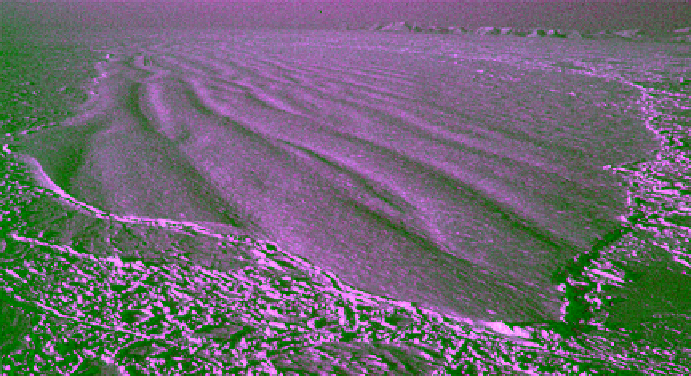Geology Reference
In-Depth Information
Figure 5.37
Aerial photo showing corrugated shelf ice section of the Hobson's Choice ice island (courtesy, Polar
Continental Shelf Project).
testing on the MY ridged sea ice in March-April 1989
and 1990 to be described later, the island was located at
about 79°23.5′N; 102°20.2′W, close to the northern tip of
Ellef Rignes Island (see Figure 5.35).
Although the strength and deformation aspects of sea
or other types of ice are outside the scope of this topic, it
is appropriate to mention here that extensive studies on
the physical characteristics were indeed carried out on ice
island ice. Only a brief description of these activities will
be given in the following paragraph.
Frederking et al.
[1988] were the first group of research-
ers to publish data on mechanical properties, particularly
uniaxial compressive strength, of shelf ice component of
Hobson's Choice ice island. They performed their tests in
a cold room at NRC, Ottawa, and used the old conven-
tional methods of constant cross‐head rate or nominal
strain rate uniaxial compression tests. The tests were per-
formed at a nominal strain rate of 1 × 10
−5
/s on specimens
from the upper surface of a hummock of shelf ice on
Hobson's Choice. Subsequently,
Jeffries et al.
[1990]
performed a series of state‐of‐art, closed‐loop controlled
constant strain rate uniaxial compression tests at NRC,
Ottawa, in a wide range of strain rates from 2 × 10
−7
/s
to 1 × 10
−3
/s). Compression failure stress (compressive
strength) and failure modulus were determined for 13
hummock and 11 depression specimens taken from areas
near the surface to as much as 36 m below the surface of
the shelf ice component of Hobson's Choice. These tests
provided information, for the first time in sea ice history,
on the actual strain rate sensitivity of strength and defor-
mation or ductility of ice from the hummock and depres-
sion specimens of shelf ice. Compressive strength was
found to increase from a low value of about 1.5 MPa at a
strain rate of 2 × 10
−7
/s to a high value of about 6.8 MPa
at a strain rate of 1 × 10
−3
/s
1
. This type of strain rate
Test site
PCSP
camp
Shelf-fast
rubble
my ice
My pack
ice
Air
strip
Ward hunt
shelf ice
5 km
Figure 5.38
Schematic of ice island showing corrugated Ward
Hunt Ice Shelf, older pre‐1982 shelf‐fast MY rubble field,
newer post‐1982 MY rubble produced by pack ice, the PCSP
camp, the airstrip and the site for 65 m long trench‐based
medium‐scale indentation tests of 1989 and 1990 (sketch by
N. K. Sinha, unpublished).
mass exceeded 7 × 10
8
tonnes [
Jefiries, et al
., 1988;
Jeffries
and Sackinger
, 1989]. The surface of the shelf ice compo-
nent was distinguished by an undulating topography of
nearly parallel hummocks and depressions, spaced about
200 m apart and extending for thousands of meters, as
can be seen in the photograph (Figure 5.37). PCSP built a
campsite in 1984 on one of the hummocks schematically
illustrated in Figure 5.38 and photographically presented
in Figure 5.39. During the 2 years of large‐scale trench


